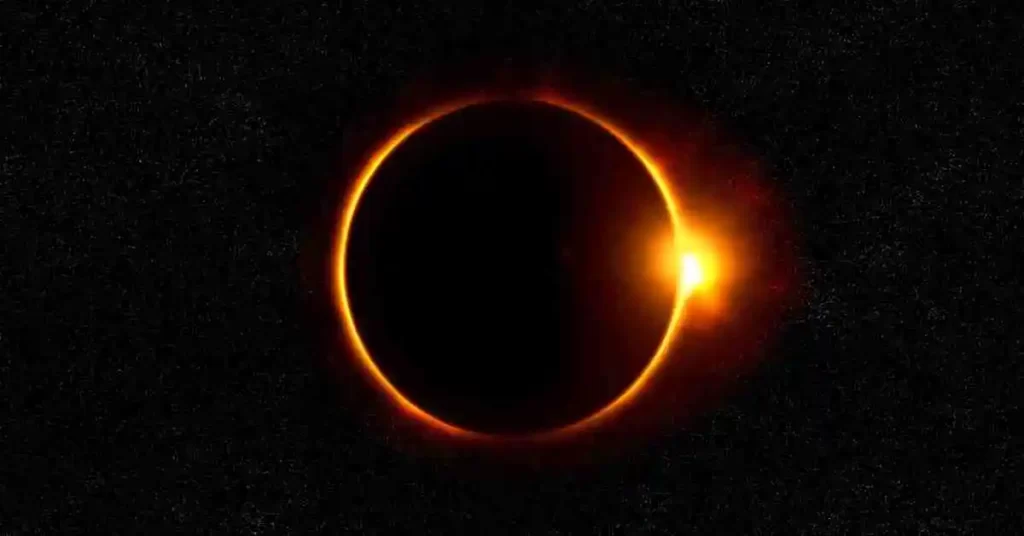A total Solar Eclipse is happening on April 8th! Witness the sun disappear for minutes in parts of North America. Read this post for timings, safety tips, and how to watch it live online even if you’re not in the path of totality!

Mark your calendars! On April 8, 2024, skywatchers in North America will be treated to a spectacular celestial event – a total solar eclipse. The moon will completely obscure the sun’s disk, plunging parts of the continent into a brief twilight for a few minutes. This blog post will be your one-stop guide to this awe-inspiring phenomenon, covering the eclipse’s timing, duration, visibility path, and how to witness it safely, even if you’re not directly in its path.
A Total Solar Eclipse on April 8th
What is solar eclipse 2024?
A solar eclipse is an astronomical phenomenon where the Moon passes between the Earth and the Sun and completely or partially blocks the Sun’s light.
When the Moon completely covers the Sun, its shadow falls on Earth, creating a “path of totality”. This path is a relatively narrow strip that runs across the surface. People standing inside this band can see a total solar eclipse, provided the weather and clouds cooperate. At the path of totality, where the Moon completely covers the Sun, the sky will become dark, as if it is morning or evening.
Unless people are on that line – the path of totality – they will only see a partial eclipse. Depending on how much the Moon blocks the Sun where they are, the sky will appear to them to be a little bit darker than it was before the eclipse.
Date and time of total Surya Garhan | Surya Garhan kab or kaha hoga
The total solar eclipse of 2024 will occur on April 8. The complete darkness of the sky, also known as totality, will be visible for a distance of 185 kilometers between Mexico, the US and Canada. It will also be seen in 18 different states of America. However, it will not be visible to skywatchers in India,
As per Indian Standard Time (IST), the total solar eclipse will start at 9:12 pm on April 8, the total solar eclipse will start at 10:08 pm and end at 2:22 am on April 9, 2024. The Pacific coast of Mexico will be the first to experience totality at 11:07 a.m. PDT, and the event will exit Maine at approximately 1:30 a.m. PDT.
- Pacific Standard Time (PST): Begins around 9:05 AM PST
- Mountain Standard Time (MST): Begins around 10:05 AM MST
- Central Standard Time (CST): Begins around 11:05 AM CST
- Eastern Standard Time (EST): Begins around 12:05 PM EST
- Indian Standard Time (IST): Begins at 9:12 PM IST on April 8th (evening of April 7th for you!)
Safety First: Never look directly at the sun!
It is important to remember that looking directly at the Sun, even during an eclipse, can cause permanent damage to the eyes. Here are some safe ways to view the eclipse:
- Special solar eclipse glasses: These glasses have special filters that block harmful solar radiation, allowing you to view the eclipse directly.
- Solar Projection: Project the image of the Sun onto a white piece of cardboard using a telescope or binoculars (with appropriate solar filters attached). This makes it a safe way to view the eclipse indirectly.
- Live Stream: If you’re not on the path of totality or don’t have the proper equipment, many organizations will host live streams of the eclipse. We’ll discuss those options in detail later!
Duration of Totality: A Breathtaking Spectacle
This eclipse promises to be a sight to behold, with totality lasting an impressive up to 4 minutes and 28 seconds at its peak. This surpasses the duration of the 2017 eclipse, making it an even more extraordinary event for skywatchers.
Read more: NASA to Launch 3 Rockets During April Solar Eclipse to Study Atmospheric Disturbances
Once in a lifetime opportunity: prepare to be surprised!
The total solar eclipse on April 8 presents a unique opportunity to view a breathtaking astronomical display. By understanding the timing, path, safety precautions, and live stream options, you can be fully prepared to experience this unforgettable event. Whether you’re watching live or virtually, this eclipse promises to be a captivating reminder of the wonders of our universe.
Witnessing the Eclipse Virtually: Live Streaming Options
Even if you’re not fortunate enough to be in the path of totality, you can still experience the magic of the eclipse through live streams. Here are a few of the best choices:
- NASA TV: The National Aeronautics and Space Administration (NASA) will be providing a live stream of the eclipse with expert commentary and views from various locations along the eclipse path. Tune in to their website or social media channels for details.
Frequently Asked Question: Solar Eclipse 2024
What is a solar eclipse?
A solar eclipse occurs when the Moon passes between the Earth and the Sun, completely or partially blocking the Sun’s light.
When and where is the total solar eclipse happening?
The total solar eclipse will occur on April 8th, 2024, with the path of totality stretching across parts of Mexico, the United States, and Canada. It will not be visible from India.
Is it safe to look directly at the sun during the eclipse?
Absolutely not! Looking directly at the sun, even during an eclipse, can cause permanent eye damage. Use special solar eclipse glasses or safe projection methods to view the eclipse.
How long will totality last?
Totality, the period of complete darkness, can last up to 4 minutes and 28 seconds at its peak during this eclipse.
Can I watch the eclipse online if I’m not in the path of totality?
Yes! Several organizations like NASA TV will be hosting live streams of the eclipse.

Leave a Reply